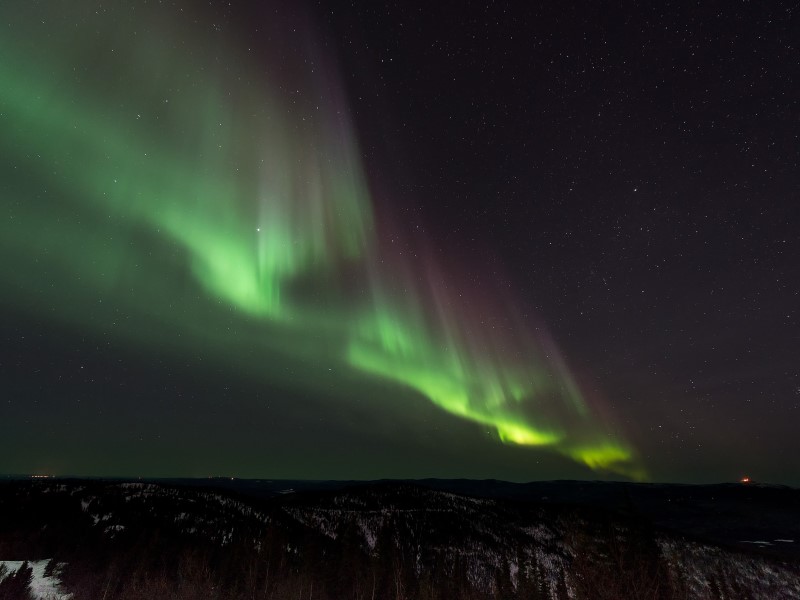- Home
- Science
- Science News
- Nasa Looks to Citizen Sky Gazers to Decode Auroras
Nasa Looks to Citizen Sky Gazers to Decode Auroras

The US space agency is using citizen science observations to unlock the secrets behind auroras - geomagnetic storms that are beautiful but can also cause power outages and interrupt satellite systems.
One such space weather scientist, Liz MacDonald has seen auroras more than five times in her life.
MacDonald, now at Nasa's Goddard Space Flight Center in Greenbelt, Maryland, founded Aurorasaurus - a citizen science project that tracks auroras through the project's website, mobile apps and Twitter.
On the evening of October 24, 2011, MacDonald was left amazed - not by any bright, dancing lights in the sky but by the number of aurora-related tweets on her computer screen.
People across the eastern US tweeted about seeing the aurora in real-time. This storm became one of the first wide-scale documentations of aurora activity with social media.
In a study published in AGU's Space Weather journal, the team found that citizen scientists are regularly able to spot auroras farther south of an area where prediction models indicated.
"Using these observations, we can make better short-term predictions of when and where the aurora is for aurora enthusiasts - and scientists," said MacDonald.
Though many satellites study the Sun and near-Earth space environment responsible for auroras, predicting where, when and how strongly the dancing natural light display -- and the geomagnetic storm - will occur on Earth is still challenging.
After analysing 500 citizen science aurora observations during March and April 2015, the Nasa team found that many people reported seeing the aurora further equatorward (that is, farther south in the Northern Hemisphere, and farther north in the Southern Hemisphere).
The team now incorporates the citizen science observations to improve the aurora view-line on the project's map.
"Without the citizen science observations, Aurorasaurus wouldn't have been able to improve our models of where people can see the aurora," said study's lead author, Nathan Case, senior research associate at Lancaster University in Britain.
Sky watchers can submit their aurora sightings directly to aurorasaurus.org or use the free Aurorasaurus mobile apps.
The project also searches Twitter using keywords to find aurora-related tweets.
Users can then confirm or deny these crowdsourced tweets. The submitted observations and verified tweets are displayed on a global map showing real-time auroral visibility.
For the latest tech news and reviews, follow Gadgets 360 on X, Facebook, WhatsApp, Threads and Google News. For the latest videos on gadgets and tech, subscribe to our YouTube channel. If you want to know everything about top influencers, follow our in-house Who'sThat360 on Instagram and YouTube.
Related Stories
- Samsung Galaxy Unpacked 2025
- ChatGPT
- Redmi Note 14 Pro+
- iPhone 16
- Apple Vision Pro
- Oneplus 12
- OnePlus Nord CE 3 Lite 5G
- iPhone 13
- Xiaomi 14 Pro
- Oppo Find N3
- Tecno Spark Go (2023)
- Realme V30
- Best Phones Under 25000
- Samsung Galaxy S24 Series
- Cryptocurrency
- iQoo 12
- Samsung Galaxy S24 Ultra
- Giottus
- Samsung Galaxy Z Flip 5
- Apple 'Scary Fast'
- Housefull 5
- GoPro Hero 12 Black Review
- Invincible Season 2
- JioGlass
- HD Ready TV
- Laptop Under 50000
- Smartwatch Under 10000
- Latest Mobile Phones
- Compare Phones
- Moto G15 Power
- Moto G15
- Realme 14x 5G
- Poco M7 Pro 5G
- Poco C75 5G
- Vivo Y300 (China)
- HMD Arc
- Lava Blaze Duo 5G
- Asus Zenbook S 14
- MacBook Pro 16-inch (M4 Max, 2024)
- Honor Pad V9
- Tecno Megapad 11
- Redmi Watch 5
- Huawei Watch Ultimate Design
- Sony 65 Inches Ultra HD (4K) LED Smart TV (KD-65X74L)
- TCL 55 Inches Ultra HD (4K) LED Smart TV (55C61B)
- Sony PlayStation 5 Pro
- Sony PlayStation 5 Slim Digital Edition
- Blue Star 1.5 Ton 3 Star Inverter Split AC (IC318DNUHC)
- Blue Star 1.5 Ton 3 Star Inverter Split AC (IA318VKU)

















